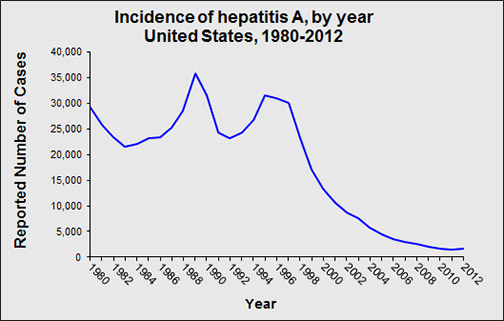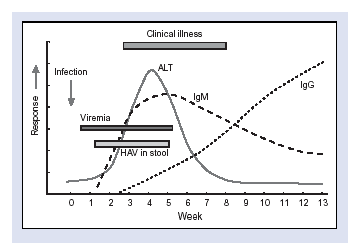Background on Hepatitis A
Your supervisor says:
"There has been a steady increase in the number of cases. They asked us to help investigate the source of the outbreak. So this will be your first assignment. I want you to be involved in all aspects of the case, including investigation of the outbreak, making recommendations regarding control and prevention (including organizing IG administration if you decide it's necessary), collection and analysis of data to determine the source, reviewing their sanitation procedures, and helping them organize training and educational to prevent future problems. Here are some quick references on hepatitis that might be useful to you. Take a look at these. The CDC Fact Sheet is particularly useful, because it gives the essential facts in a concise format. When you are finished, I'll quiz you to see if you understand the background material."
- Diagnosis and Management of Foodborne Illnesses: "A Primer for Physicians and Other Health Care Professionals"
- Hepatitis A section in MA DPH "Guide to Surveillance and Reporting"
- CDC Fact Sheet on Hepatitis A
- CDC Article on Hepatitis A
This link may also be of interest:
Note also that the incidence of hepatitis A in the United States has fallen dramatically as a result of the introduction of a vaccine for hepatitis A.

Source: http://www.cdc.gov/hepatitis/Statistics/
Your supervisor continues:
"As you know, the public health issues for hepatitis A are based on the biology of the disease. Let me ask you a few questions about the biology and epidemiology of hepatitis A."

Events During Hepatitis A Infection
The graph below helps in understanding the sequence of events during hepatitis A infection. After ingestion the virus is taken up by the gastrointestinal tract and travels by blood to the liver where it infects liver cells and replicates inside them, causing them to burst when new virus particles are released. Cell bursting releases enzymes normally inside the liver cells, such as ALT, AST, and alkaline phosphatase, and concentrations of these enzymes in the blood become abnormally high.
is taken up by the gastrointestinal tract and travels by blood to the liver where it infects liver cells and replicates inside them, causing them to burst when new virus particles are released. Cell bursting releases enzymes normally inside the liver cells, such as ALT, AST, and alkaline phosphatase, and concentrations of these enzymes in the blood become abnormally high.

Source: http://www.cdc.gov/mmwr/preview/mmwrhtml/rr5304a1.htm
Some replicated viruses get into the blood and others are secreted into bile, which enters the intestine and deposits many virus particles into the intestine causing high concentrations of virus in stool. Infected people are most infectious during the period from two weeks before the appearance of symptoms until one week after symptoms began. The average incubation period (time period between infection and development of symptoms) is about 28 days, with a range of 15-50 days. This will be important to understanding the course of the epidemic in a population.
A positive test for anti-HAV IgM clinches the diagnosis of acute infection. After recovery, the IgM gradually declines, but anti-HAV IgG increases, which confers immunity against another hepatitis A infection. So, if someone has elevated blood levels of anti-HAV IgG, but not IgM, it indicates that they had a past infection that resolved.
clinches the diagnosis of acute infection. After recovery, the IgM gradually declines, but anti-HAV IgG increases, which confers immunity against another hepatitis A infection. So, if someone has elevated blood levels of anti-HAV IgG, but not IgM, it indicates that they had a past infection that resolved.





